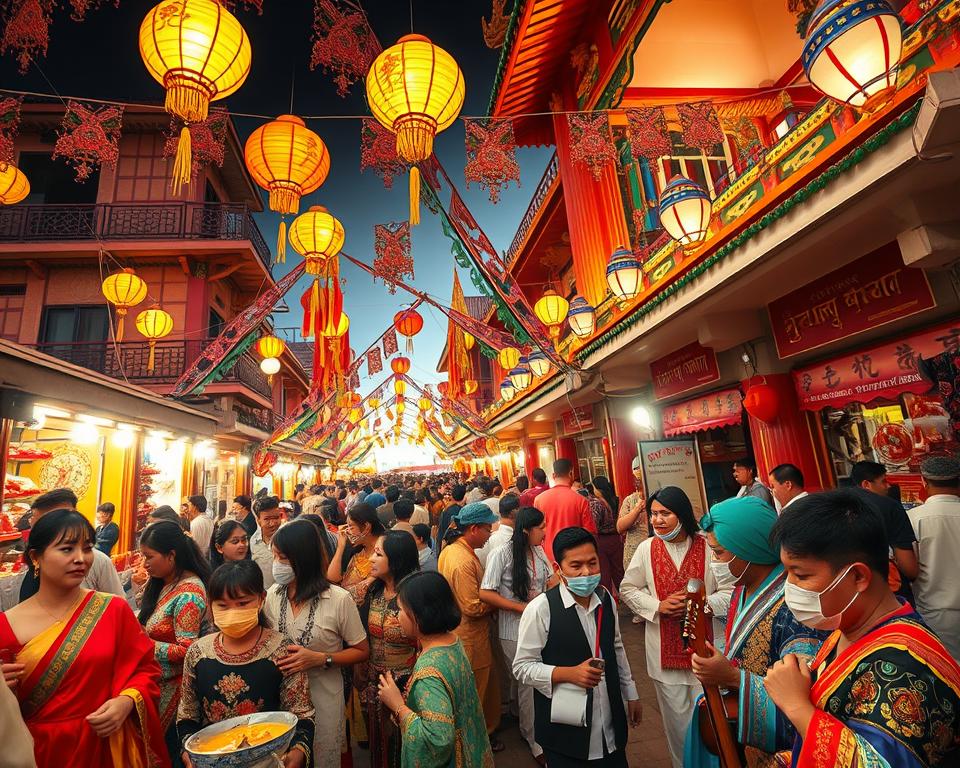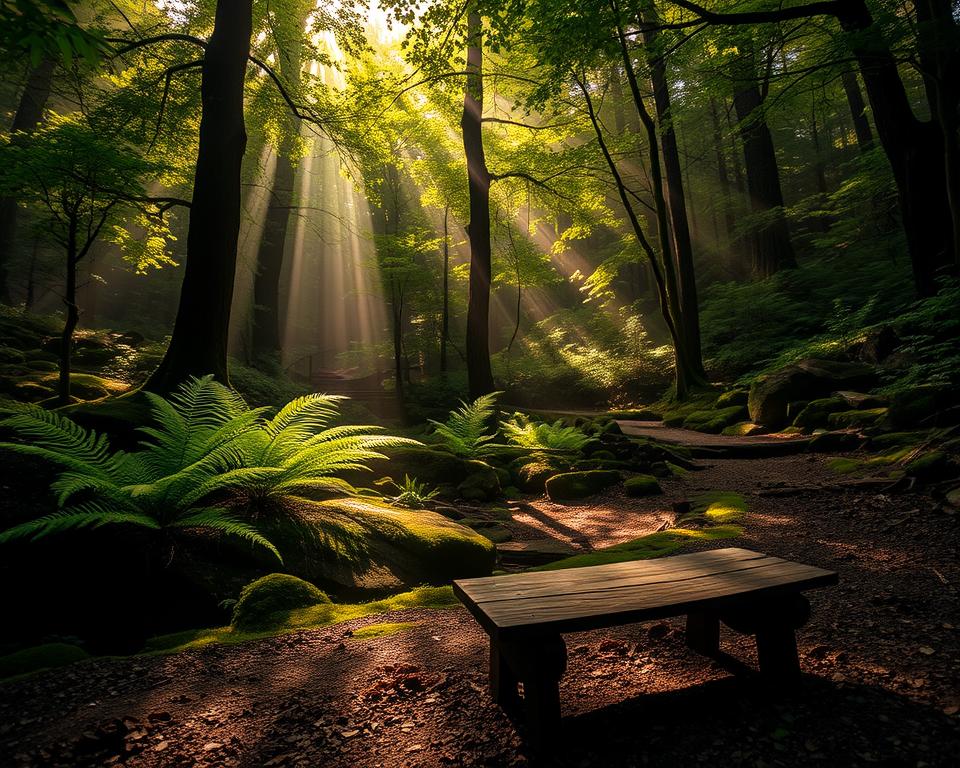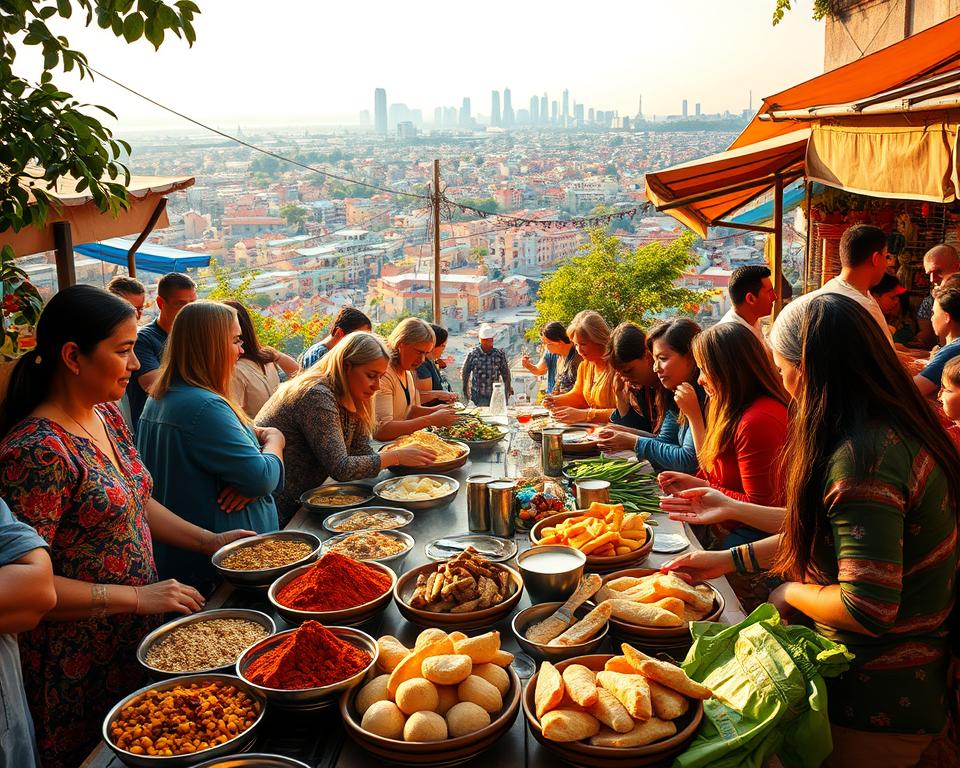Anúncios
Have you ever wondered if one meal or a single conversation could change how you see a place? cultural travel experiences can do just that. When you plan with people and moments in mind, you shift from ticking boxes to noticing living culture.
Immersion matters because it adds context and empathy to famous sites and history. You might learn to cook makloubeh in Jordan or stay in a Bedouin tent in Wadi Rum and see how daily rhythms shape life. Short exchanges—tasting food with a family or asking questions in a market—often become the memories you keep the longest.
This guide gives simple steps, real examples, and current insights so you can add small, respectful practices to any city or destination. You won’t get a promise of perfection, but you will find practical ideas to plan responsibly and adapt as you go. Always check official tourism boards and community resources for up-to-date guidance today.
Why Cultural Travel Experiences Matter Today
A single street-side chat can reshape how you remember an entire city.
From sightseeing to insight, immersion brings stories into focus. Talk with people. Learn a few local phrases. Taste home-style food. These small steps change the way a place sticks with you.
Anúncios
The role of locals, language, art, and shared moments is clear.
- Talk: Ask a vendor about ingredients and you learn history and craft.
- Listen: Locals know rhythms of life that guide how neighborhoods work.
- Try: A cooking class or a short language exchange opens practical doors.
Examples help. A street food chat in Hoi An or a cup of chai in India can be the memory you carry home. City visits add immediate context. Rural time deepens perspective.
“Even one respectful exchange can turn a sight into a story.”
Anúncios
Make notes privately. Slow down for brief moments. In this way, you bring culture into your daily life long after you leave.
How to Practice Cultural Immersion Respectfully
Simple habits help you learn about daily life instead of just seeing landmarks. Start with small, practical steps that show respect and build trust.
Everyday respectful steps
- Learn a few greetings: Say hello, please, and thank you in the local language. Practice pronunciation kindly.
- Ask before photos: Seek consent from people. A quick question honors privacy and dignity.
- Support local businesses: Buy from neighborhood vendors, co‑ops, and craftspeople to keep money in the community.
Balance icons with neighborhood time
Pair a major site with a market lunch, a short walk in a nearby neighborhood, or a visit to a community project. This mixes famous sights with daily life and living traditions.
Volunteer and give back wisely
Research locally led, transparent groups before you offer help. Vetted programs—like after‑school work in Guatemala—explain roles and protect community priorities.
“Respectful immersion is a choice you make many times a day.”
Ask locals for guidance on dress and etiquette. Move slowly, listen more than you speak, and leave space for unplanned moments that you may remember for years. These small choices shape the way you meet people today.
Join Culture-Focused Tours for Depth and Access
Small, expert‑run tours give you access, context, and safety so you can concentrate on what matters. A guided option handles logistics—transport, lodging, some meals—so you spend more time listening, tasting, and meeting people.
Why guided trips work
Local expertise: Guides explain history, point out craft details, and arrange visits to studios and family kitchens that are tough to book alone.
Smooth logistics: A clear pace and vetted suppliers mean fewer surprises on busy days.
Small-group dynamics
Groups usually run 8–16 people, which keeps numbers low and conversation rich. Solo travelers fit in well and often find new friends while keeping a few free days to explore on your own.
Real examples
- Sicily: stroll Noto and Ragusa Ibla, pair baroque visits with food tastings.
- Peru: an Amantani homestay offers daily routines, stories, and lakeside sunsets.
- Egypt: Cairo to Luxor blends felucca rides, markets, museums, and temples.
“A good guide opens doors you didn’t know existed.”
Read trip notes and activity ratings so the pace and style match your energy and interests. Tours are an option for deeper access—not a one‑size‑fits‑all promise.
Iconic Music and Heritage in the American South
In the American South, sound and memory combine to teach you a different kind of history. You can spend a day tracing how songs, stages, and civic action shaped public life.
Nashville’s live music culture: Ryman Auditorium and the Grand Ole Opry
Nashville lives up to its Music City name. Catch a live show at the Ryman Auditorium or the weekly Grand Ole Opry to hear how performance ties sound to place.
Add the Country Music Hall of Fame, Studio B, and The Johnny Cash Museum to trace how recording art evolved across years. A backstage tour shows how crews and performers make each day’s show come alive.
Listen locally: Visit hot chicken joints and neighborhood bars where emerging artists test new music. These spots let you hear tomorrow’s sounds up close with the people who make them.
Walking the Civil Rights story in Montgomery with veteran guides
Montgomery, Alabama’s capital, links streets, faith, and policy in clear ways. Veteran guides lead walks that stop at Dexter Avenue King Memorial Baptist Church and the Alabama State Capitol.
The route often includes the Civil Rights Memorial and the Rosa Parks Museum. Guides share first-hand accounts so you can connect civic decisions, courage, and community action.
- Sites: Ryman, Opry, Hall of Fame, Studio B, Johnny Cash Museum.
- Streets & squares: Dexter Avenue, the Capitol, memorials and museums.
- Small group value: Walking with a group deepens context and keeps visits respectful.
“Music and public memory live side by side; walking with people who know the story brings both into focus.”
Food, Drink, and Craft Traditions You Can Taste
Hands-on cooking and sipping reveal how communities shape flavor over time. When you join a local class or a well-run tour, you learn recipes and the stories behind them. That turns a taste into a memory.
Cook with locals: hands-on lessons and markets
Book a local cooking class where you flip makloubeh in Jordan or steam Tibetan momos. You gain technique and the hospitality stories that come with each dish.
Visit a market first: Choose seasonal produce with your host so ingredients and methods feel alive. This practice helps you recreate the traditions at home.
The Kentucky Bourbon Trail: tastings and craft
The Bourbon Trail spans around 46 distilleries, from Woodford Reserve to Wild Turkey. You can taste guided flights, join a mint julep cocktail class, and see aging rooms where years of patience shape flavor.
A good tour mixes large sites with small craft distilleries so you compare methods and meet makers. Some stops let you bottle a single barrel and label it yourself—a hands-on way to learn standards and care.
- Pairing tip: Combine distillery days with local meals to taste how regional dishes balance sweetness, smoke, and spice.
- Safety first: Use a designated driver or book guided transfers and pace tastings with water and food.
“Tasting with context turns a sip into a story.”
Festivals that Define Place and Community
When a city stages its signature festival, you see what the community values most. Festivals compress months of art, history, and public life into a few shared days.

Calgary Stampede: western heritage, Powwow, and Elbow River Camp
The Stampede runs 10 days in early July. Each day moves from rodeo contests and chuck wagon races to concerts and a grandstand show with fireworks.
Visit the Stampede Powwow and Elbow River Camp to watch Indigenous dance, meet people in the 26 tipis, and learn about foodways like bison dishes and craft protocols.
Albuquerque International Balloon Fiesta: dawn patrol to night glow
The Balloon Fiesta runs nine days in October. Early mornings bring the Dawn Patrol and a mass ascension around 7 a.m.; evenings offer the dramatic night glow and drone light shows.
Pause in Old Town’s adobe streets for a calm afternoon break. Both events reward early arrivals, layered clothing, and steady hydration.
- Plan buffer days: rest, visit museums, and pace long schedules.
- Use official apps: track weather and schedule changes.
- Be a mindful guest: pack out trash, keep walkways clear, and thank volunteers whose work shapes each day.
“Festivals reveal a country’s spirit through shared work, talent, and storytelling.”
Indigenous Culture and Living Heritage
Listening to elders and guides opens a different kind of map—one made of stories and memory.
Choose Indigenous‑led visits where knowledge holders set the pace and explain protocols. That approach helps you notice why protection, place, and memory matter.
Nova Scotia: Mi’kmaq petroglyph walks and workshops
At Kejimkujik National Park guided petroglyph walks reveal symbols, landscape use, and local history. Guides explain why viewing respectfully protects sites for future generations.
At Millbrook Cultural and Heritage Centre, drum and craft workshops connect art to daily life. You can learn bannock making, try a drum circle, and practice a few words in the local language as a sign of respect.
Newfoundland: kitchen parties, music, and food
In St. John’s, kitchen parties blend jigs, reels, story, and shared plates. Join only when invited and listen first.
Taste fish and brewis or toutons to understand how maritime foodways grew over years through work at sea and at home.
- Seek Indigenous leadership: support programs run by community members.
- Ask about photos: follow hosts’ rules for sharing and consent.
- Listen first: each region shapes its lessons differently.
“These moments are about relationship, not performance.”
Leave visits with a simple thanks; gratitude honors the people who taught you and keeps heritage alive.
Great Cities and Ancient Sites for Cultural Context
Pairing major cities with nearby ruins helps you read history across space and time. Start in an urban hub, then move outward to monuments and smaller shrines so the past feels continuous.
Egypt: Cairo to Luxor — museums, markets, and the Nile’s temple corridor
Begin in Cairo to split time between the Egyptian Museum, busy markets, and the Giza plateau that defines world heritage.
Take a well-planned tour along the Nile to Luxor, stopping at Edfu and Kom Ombo. A felucca ride at sunset changes how you see river life and temple reliefs.
Structure Luxor days around the Valley of the Kings and Karnak. Add smaller sites so you do not rush the story each monument tells about history and ruins.
Morocco: medinas and kasbahs — Fez, Sahara nights, and Essaouira
Medinas are living cities. Use local guides to navigate Fez’s layers of craft, scholarship, and daily trade in tight markets.
Plan an overnight in the Sahara to watch the sky at night. Then follow the Route of the Thousand Kasbahs to see how communities adapted to the land and its ruins.
End at Essaouira to feel sea breezes, walk fort walls, and enjoy a relaxed art scene that contrasts with Marrakech’s Djemaa el Fna energy.
- Tip: Start in Cairo for the museum, markets, and Giza plateau.
- Tip: Let felucca sails and sunset light reveal temple scale and craft.
- Tip: Check official ticketing and mosque prayer times; dress and behave with respect.
“Pair cities and ancient sites to build a coherent map of the past.”
Nature Meets Culture: Trails, Islands, and Rural Life
Where mountains meet villages, the landscape also carries the stories of those who tended it for generations.
Path of the Gods and Amalfi villages
Hike the Path of the Gods from Bomerano and link the trail to markets in Amalfi and Positano.
Plan a day that pairs a morning ridge walk with afternoon tastings at a family farm and an evening in a small square. Ravello’s Villa Cimbrone views reward slow pacing, and a Capri sail adds sea air between stops.
Side trips to Herculaneum or Pompeii show how landscape and ancient planning shaped cliff towns over years.
Peru’s Sacred Valley to Amantani homestays
In the Sacred Valley, villages teach weaving steps and seasonal farming cycles. On Amantani, a homestay gives you hands-on insight into Quechua life and language.
Share simple tasks and meals, learn a few key phrases, and ask hosts what small gift from your place is appropriate. Note that transportation and altitude affect timing, so build buffer time and rest options into your plans.
“These cultures meet you outdoors; listening to land-based knowledge is part of responsible practice.”
- Tip: Move slowly and let the land guide what you learn.
- Tip: Pack flexible plans so you catch both nature and local rhythms.
Designing Your Own Cultural Day in Any City
Designing one flexible day can turn a regular visit into a clear window on local life. Use simple steps you can copy in most cities. Keep the pace slow and leave room for questions.
Morning markets, artisan workshops, and language exchanges
Start early at local markets to watch vendors set up. Ask polite questions about ingredients and choose a snack that ties you to the place.
Late morning, visit an artisan workshop or co‑op. Plan one demo and one hands‑on stop so you have time to learn without rushing.
Try a short language exchange or a beginner class to practice greetings and directions you will use that day.
Ride public transit, attend a neighborhood event, and eat where locals do
At midday, take public transit to see routes, etiquette, and rhythm—this shows the way a city moves better than a taxi.
Scan community calendars for a small neighborhood talk, dance class, or concert to meet locals and learn what matters to them.
- Lunch & dinner: Eat where locals go and ask staff how a dish is usually shared.
- Late walk: Stroll a residential street to catch routines you missed earlier.
- Group option: Join a small group activity to add structure and save on costs during your trip.
“A short, well‑planned day shows you more than a checklist ever will.”
Responsible Planning and Useful Resources
A careful plan protects local rhythms and makes your visit more meaningful.
Start with official sources: check tourism boards and local cultural centers to confirm hours, ticketing at historical sites, and any public guidance that applies today.
Check calendars and tour details
Review tour descriptions and trip notes for activity ratings, group sizes, and free time. That helps you match the right tour and destination to your energy and goals.
Book ethical experiences
Look for community partnerships, local ownership, and transparent pay so your spending supports the right part of the economy.
- Compare how many people join a group and whether visits include visits to historical sites or museums with timed entries.
- Check workshop calendars across recent years to spot patterns in demand and seasonality.
- Verify guide affiliations and ties to local communities before you book.
“Responsible research keeps benefits local and visits respectful.”
Plan buffers around timed entries, weather, and transit. Keep a short list of essential contacts—operators, museum sites, and your accommodation—so you can adapt plans and enjoy your part of the world with less stress.
Conclusion
A short wrap-up helps you keep what mattered—people, places, and small moments—long after you return.
Blend museums with markets, concerts with conversations, and guided walks with unplanned stops. Let memories from Montgomery, the Ryman and Grand Ole Opry, the Calgary Stampede, Albuquerque’s Balloon Fiesta, Mi’kmaq petroglyph walks, Newfoundland kitchen parties, the Path of the Gods, Morocco’s medinas, Nile felucca rides, and Amantani homestays shape your view.
Choose a few meaningful visits, book ethical tours (often 8–16 people), try a cooking class like making makloubeh, and say hello in the local language. Check official sites for hours and festival dates so your planning stays practical today.
Travel with humility and curiosity. Support community‑led programs, and let small moments on city streets or at a festival become the part of your life that lasts for years.



